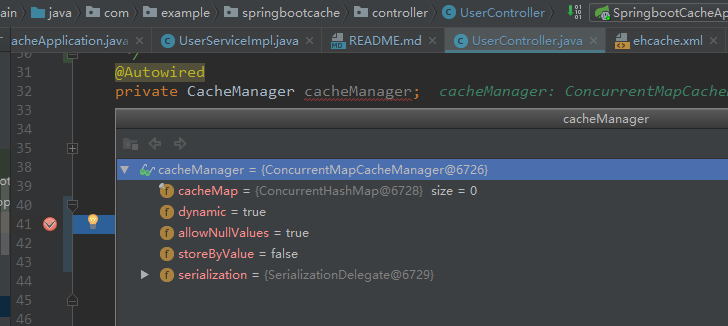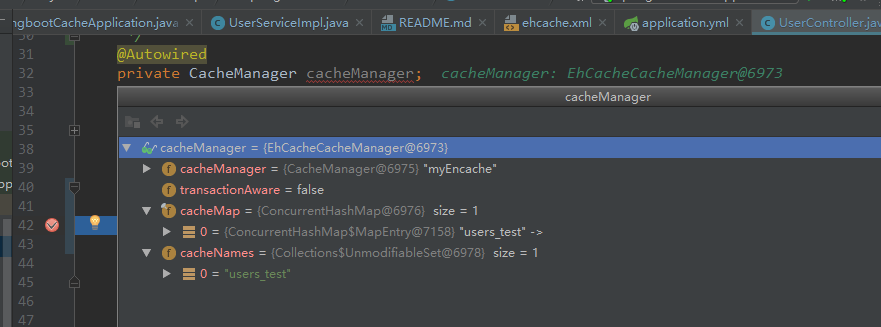1、CacheManager
Spring Boot默认集成CacheManager,如下包所示:

可以看出springboot自动配置了 JcacheCacheConfiguration、 EhCacheCacheConfiguration、HazelcastCacheConfiguration、GuavaCacheConfiguration、RedisCacheConfiguration、SimpleCacheConfiguration 等。
默认的CacheManager为ConcurrenMapCacheManager,Spring从Spring3.1开始基于java.util.concurrent.ConcurrentHashMap实现的缓存管理器。Spring Boot 默认使用 ConcurrentMapCacheManager作为缓存技术。新建一个springboot项目,直接使用cache相关注解来测试,效果如下:

2、整合encache
pom依赖引入
<!--开启 cache 缓存 --> <dependency> <groupId>org.springframework.boot</groupId> <artifactId>spring-boot-starter-cache</artifactId> </dependency> <!-- ehcache 缓存 --> <dependency> <groupId>net.sf.ehcache</groupId> <artifactId>ehcache</artifactId> </dependency>
application文件配置
spring:
cache:
#ehcache配置文件路径
ehcache:
config: classpath:/ehcache/ehcache.xml
#指定缓存类型,可加可不加
#type: ehcache
encache.xml文件
<?xml version="1.0" encoding="UTF-8"?> <ehcache name="myEncache"> <!-- diskStore:为缓存路径,ehcache分为内存和磁盘 2级,此属性定义磁盘的缓存位置 user.home - 用户主目录 user.dir - 用户当前工作目录 java.io.tmpdir - 默认临时文件路径 --> <diskStore path="D:/home/Tmp_Ehcache"/> <!-- name:缓存名称。 maxElementsInMemory:缓存最大数目 maxElementsOnDisk:硬盘最大缓存个数。 eternal:对象是否永久有效,一但设置了,timeout将不起作用。 overflowToDisk:是否保存到磁盘,当系统宕机时 timeToIdleSeconds:设置对象在失效前的允许闲置时间(单位:秒)。仅当eternal=false对象不是永久有效时使用,可选属性,默认值是0,也就是可闲置时间无穷大。 timeToLiveSeconds:设置对象在失效前允许存活时间(单位:秒)。最大时间介于创建时间和失效时间之间。仅当eternal=false对象不是永久有效时使用,默认是0.,也就是对象存活时间无穷大。 diskPersistent:是否缓存虚拟机重启期数据 Whether the disk store persists between restarts of the Virtual Machine. The default value is false. diskSpoolBufferSizeMB:这个参数设置DiskStore(磁盘缓存)的缓存区大小。默认是30MB。每个Cache都应该有自己的一个缓冲区。 diskExpiryThreadIntervalSeconds:磁盘失效线程运行时间间隔,默认是120秒。 memoryStoreEvictionPolicy:当达到maxElementsInMemory限制时,Ehcache将会根据指定的策略去清理内存。默认策略是LRU(最近最少使用)。你可以设置为FIFO(先进先出)或是LFU(较少使用)。 clearOnFlush:内存数量最大时是否清除。 memoryStoreEvictionPolicy:可选策略有:LRU(最近最少使用,默认策略)、FIFO(先进先出)、LFU(最少访问次数)。 FIFO,first in first out,这个是大家最熟的,先进先出。 LFU, Less Frequently Used,就是上面例子中使用的策略,直白一点就是讲一直以来最少被使用的。如上面所讲,缓存的元素有一个hit属性,hit值最小的将会被清出缓存。 LRU,Least Recently Used,最近最少使用的,缓存的元素有一个时间戳,当缓存容量满了,而又需要腾出地方来缓存新的元素的时候,那么现有缓存元素中时间戳离当前时间最远的元素将被清出缓存。 --> <defaultCache eternal="false" maxElementsInMemory="1000" overflowToDisk="false" diskPersistent="false" timeToIdleSeconds="0" timeToLiveSeconds="600" memoryStoreEvictionPolicy="LRU" /> <cache name="users_test" eternal="false" maxElementsInMemory="100" overflowToDisk="false" diskPersistent="false" timeToIdleSeconds="0" timeToLiveSeconds="300" memoryStoreEvictionPolicy="LRU" /> </ehcache>
启动类加上启用缓存注解
@EnableCaching public class SpringbootCacheApplication { public static void main(String[] args) { SpringApplication.run(SpringbootCacheApplication.class, args); } }
代码中使用cache注解
@Service public class UserServiceImpl implements UserService { @Autowired private UserMapper userMapper; //使用ehcache配置的缓存名users_test private final String USER_CACHE_NAME = "users_test"; @Override public List<User> listUser() { return userMapper.selectUserList(); } @Override // @Cacheable(value = USER_CACHE_NAME, key = "#id") @Cacheable(value = USER_CACHE_NAME, key = "'user' + #id") public User selectUserById(Integer id) { return userMapper.selectUserById(id); } @Override // @CacheEvict(value = USER_CACHE_NAME, key = "#id") @CacheEvict(value = USER_CACHE_NAME, key = "'user_' + #id") public void delete(Integer id) { userMapper.delete(id); } @Override // @CacheEvict(value = USER_CACHE_NAME, key = "#user.userId") @CacheEvict(value = USER_CACHE_NAME, key = "'user' + #user.userId") // @CachePut(value = USER_CACHE_NAME, key = "'user' + #user.userId") //测试发现只将结果清除,key未清除,导致查询继续使用缓存但结果为空???? public void update(User user) { userMapper.update(user); } }
项目启动后查看CacheManager,如下图所示则表示整合ehcache成功
